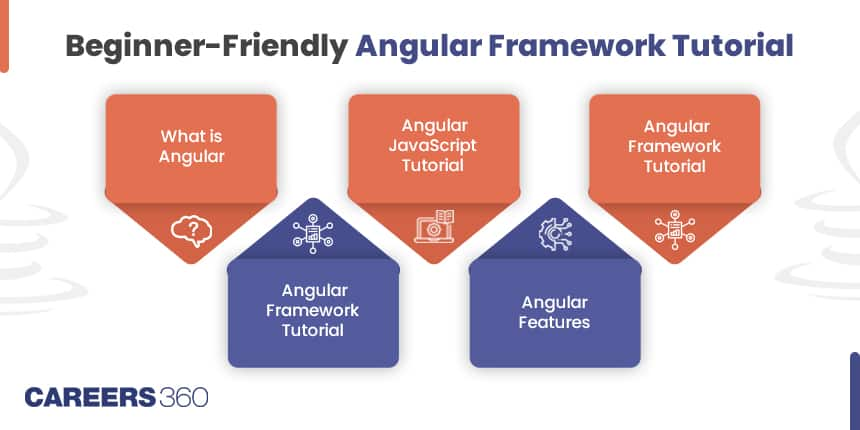Getting Started With Angular Tutorial for Beginners
In web development, Angular stands tall as a robust and versatile framework, offering a structured approach to crafting dynamic single-page web applications. This Angular tutorial is tailored for beginners, providing a gateway to understanding Angular's essence, features, and foundational elements.
Developed and maintained by Google, Angular leverages TypeScript to bring enhanced functionality and organisation to web development. If you are interested in gaining more knowledge in this field, you can have a look at Online AngularJs Courses and Certifications listed on our website.
What is Angular?
Angular is a front-end framework developed and maintained by Google, designed to simplify the creation of dynamic single-page web applications (SPAs). Leveraging TypeScript, a superset of JavaScript, Angular brings a structured and efficient approach to web development.
Also Read:
- What is Angular?
- Angular Tutorial for Beginners
- Angular Framework Tutorial
- Angular JavaScript Tutorial: Angular Language Tutorial
- Angular Features
- Building Blocks of Angular
- Related: Angular Courses by Top Providers
- Conclusion

Angular Tutorial for Beginners
Installation:
Start by installing Node.js and npm (Node Package Manager), prerequisites for Angular development.
Utilise npm to install Angular CLI, a powerful command-line interface for Angular applications.
Creating Your First Angular App:
Generate a new Angular project effortlessly using the Angular CLI.
Navigate to the project folder and initiate the development server to witness your Angular app in action.
Also Read:
Angular Framework Tutorial
Components:
Components are the fundamental building blocks of Angular applications, encapsulating specific functionality and user interface elements.
Understand how to create, use, and communicate between components in Angular.
Templates:
Angular templates, written in HTML, dictate how the application should render.
Explore the dynamic rendering of data within templates and their association with Angular components.
Directives:
Angular directives are crucial for manipulating the DOM. Directives are a powerful feature that enables you to extend the functionality of HTML elements in your templates. Learn about directives like ngIf, ngFor, and ngModel, enhancing your ability to control the application's behaviour.
Services:
Services in Angular act as singletons, providing essential functionality throughout the application.
Discover how services facilitate tasks such as data fetching, sharing information between components, and encapsulating business logic.
Also Read:
Here is how a code Illustration looks like :
// app.component.ts
import { Component } from '@angular/core';
@Component({
selector: 'app-root',
template: `
<h1>{{ title }}</h1>
<ul>
<li *ngFor="let item of items">{{ item }}</li>
</ul>
`,
styles: []
})
export class AppComponent {
title = 'Angular Example';
items = ['Item 1', 'Item 2', 'Item 3'];
}
This code displays a simple list of items
Angular JavaScript Tutorial: Angular Language Tutorial
TypeScript Basics:
TypeScript, a superset of JavaScript, introduces static typing to enhance code readability and catch errors during compilation.
Dive into TypeScript basics, including data types, interfaces, and classes.
JavaScript Integration:
Angular seamlessly integrates with JavaScript, allowing developers to leverage existing JavaScript code within Angular applications.
Explore the interoperability between TypeScript and JavaScript in an Angular context.
TypeScript Features:
TypeScript's features, including static typing, interfaces, and classes, significantly contribute to Angular's maintainability and scalability.
Delve into how TypeScript enhances the development experience in Angular projects.
Angular Features
Two-Way Data Binding:
Angular's two-way data binding simplifies the synchronisation between the application's model and view.
Learn how to harness the power of two-way data binding for efficient user input handling.
Dependency Injection:
Angular's robust dependency injection system streamlines the management and organisation of dependencies within the application.
Understand the benefits and implementation of dependency injection in Angular.
Modularity:
Angular promotes modularity by breaking down applications into smaller, reusable components.
Explore how modularity enhances code maintainability and scalability in Angular projects.
Building Blocks of Angular
Modules:
Angular applications are structured into modules, each serving a specific purpose.
Understand how modules encapsulate components, services, and other features, promoting a modular and scalable codebase.
Components:
Components are the core entities in Angular applications, encapsulating both the application's logic and user interface elements.
Learn how to create and structure components to build dynamic and interactive user interfaces.
Services:
Angular services play a pivotal role in providing functionality shared across components.
Dive into the implementation and best practices of Angular services for efficient code organisation.
Related: Angular Courses by Top Providers
Conclusion
This Angular tutorial for beginners lays a foundation for you to understand web development. By discussing Angular’s core concepts, features, and building blocks, you will have gained an understanding of how to craft modern and interactive single-page web applications. Remember, Angular is not merely a framework; it is a powerful ally that simplifies complex tasks, enhances code organisation, and fosters modular development.
The web development landscape is ever-evolving, and Angular remains at the forefront of innovation. Armed with the insights gained from this tutorial, you are well-equipped to navigate the exciting challenges and possibilities that Angular offers.
Frequently Asked Questions (FAQs)
Angular is a front-end framework developed by Google, renowned for simplifying the creation of dynamic single-page web applications. Its popularity stems from its structured approach, powerful features, and the ability to seamlessly organise and manage code.
This tutorial is tailored for beginners, offering a step-by-step guide to understanding Angular's fundamentals. Its accessible writing style, clear explanations, and hands-on examples make it an ideal starting point for aspiring web developers.
Angular distinguishes itself with features like two-way data binding, dependency injection, and a modular architecture. Its use of TypeScript, a superset of JavaScript, enhances code maintainability and scalability, setting it apart in the web development landscape.
The tutorial explores essential features such as components, templates, directives, services, and the advantages of two-way data binding, dependency injection, and modularity. Understanding these features is crucial for harnessing Angular's full potential.
The tutorial encourages hands-on practice and provides real-world use cases. Apply the knowledge gained by creating your Angular projects, experimenting with the concepts, and gradually taking on more complex challenges. The journey from tutorial to real-world application is a natural progression in mastering Angular.
Articles
Upcoming Exams
Application Date:11 November,2024 - 08 April,2025